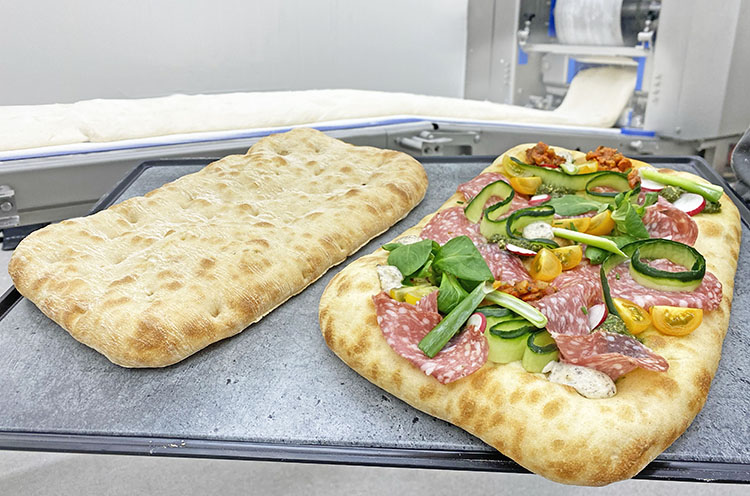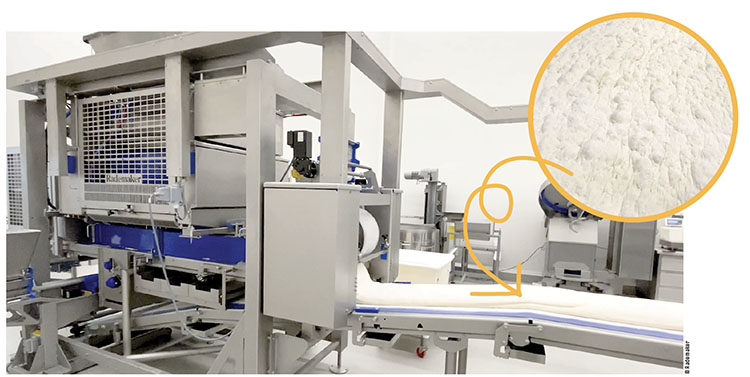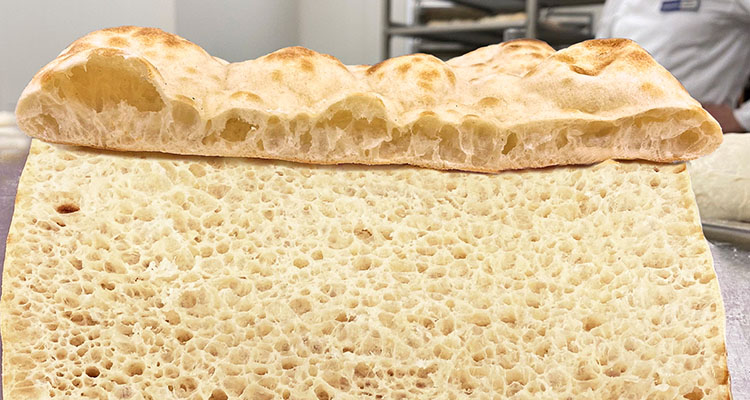
The beginnings of pinsa-making go all the way back to the Roman Empire. A fresh new take on the Roman pinsa is now rising to the top among consumer favorites all over the world. Modern techniques and new ingredients are here to help meet production needs.
Pinsa’s unique taste and flavor were the result of the baker’s artistry in preparing the dough by grinding cereals and adding the right combination of herbs into the mix. Its very name honors the process, coming from the Latin ‘pinsere’ which means to stamp, to pound. The result defines the ideal characteristics pinsa should have, starting with its oval shape; it has a crunchy exterior while remaining soft on the inside, it is easier to digest compared to regular pizza, thanks to the leavening process; and it has a strong flavor which it owes to its special flour blend, including wheat flour, rice flour, soy flour, and dried mother yeast. Its very own supporting organization, Associazione Originale Pinsa Romana, officially recognizes restaurants as Original and Certified Pinseria, following expert examination and quality control of the entire production process.
To transfer the traditional manufacturing process to high-end industrial output, Rademaker transformed the production process of this originally handcrafted specialty into an industrial production solution that maintains the crispy crust and airy structure of the pinsa.
A special recipe
Pinsa is made with a unique type of pizza dough, the result of a non-GMO flour mix comprising flours made of wheat, soy and rice. Each plays its own functional role: soy flour makes the dough crunchy, and rice flour helps retain water and makes it easy to bake. Sourdough or biga is also added, for a delicate flavor, in addition to the hallmark of the pinsa – a little yeast. Moreover, this special dough is more hydrated than traditional pizza dough and it can contain as much as 75-80% water, whereas pizza dough normally ranges between 53 to 65% water.
A key step in making pinsa dough is extended proofing, of about 72 hours. Baking is also adjusted to the requirements of the highly-hydrated dough, and is done in two stages: at first, the base is baked during par-baking, and then the dough is topped and goes for the final baking. For the industrial process, the par-baked pinsa is first cooled down, packed and frozen. In this form, it travels to the shop or restaurant, where it is defrosted, topped and goes in for the final baking.
The appeal of the pinsa
+ By combining wheat, soya and rice flour, a high percentage of water and a long proofing time, pinsa is a healthier alternative to pizza and easier to absorb.
+ Because of the high-water content, a correspondingly lower amount of flour is added to the dough and, as a result, it contains fewer carbohydrates, respectively fewer calories.
+ Pinsa is a GMO-free product with no added sugars, no added saturated fats, 100% less cholesterol and two-thirds less gluten.

Industrial production step by step
Over the centuries, the original pinsa recipe has been refined with new ingredients and the support of modern technology. Rademaker translated the traditional process intending to have a similar quality, consistently, through an industrial, dough-friendly production process. To achieve this, when forming the dough, the structure created during mixing is kept intact throughout the consequent processing steps.
Prepared before the mixing process, the sourdough is added together with the other ingredients into the mixer. The dough is then put in dough bins and undergoes fermentation over several hours. When fermentation is complete, the batches of dough are placed into the Rademaker pre-sheeter. Depending on the desired capacity, a Double-chunking Sheeting System (DSS) or Dynamic Pre-Sheeter (DPS) will be used. Both systems are specially designed for producing artisan, highly hydrated doughs. This module creates a consistent sheet of dough. It features a system that ensures the structure of the dough remains intact while sheeting.
Dough sheets of different sizes can be produced with the pre-sheeter. The production line can be used for the production of virtually any type of bread. The sheeting and make-up sections are the product-specific process steps. “That is why we have designed different sheeting and make-up units that are suitable for specific doughs. For instance, toast bread requires a very small and evenly divided cell structure, which is the complete opposite of the pinsa dough. When desired, we simply add this unit to the line configuration. In this way, the baker can make different products on one production line,” Rademaker illustrates.
To achieve doughs of various sizes in both width and thickness, for any type of dough, the pre-sheeter’s output has a dynamic dough outfeed gap function that adjusts the thickness of the dough sheet as required. Besides dough sheet thickness, the dough sheet width is also an important parameter to watch for when changing production to different types of dough. “This is centrally controlled and embedded in our operating system. Here, the operator can set the required dough sheet requirements, after which the system recalculates the settings of the modules and automatically changes them to the correct setting,” says Rademaker.
After pre-sheeting, the dough sheet is gently reduced as it goes through a combination of reduction stations. When the dough reaches the required dough thickness, it can either proceed to the inline proofing stage before product cutting or it can be directly cut into products. The newly-created dough sheet is cut into separate dough lanes, which go through a guillotine, resulting in the desired dough pieces. The make-up units transfer these dough pieces to the applicable unit to form the products. “These units are also individually able to adjust the product dimensions to the
demands of the baker,” Rademaker adds.

Any excess dough can be brought back into the production process, so none of the special pinsa dough goes to waste. “With our in-line dough recycling system, 100% of the return dough can be re-used directly onto our production line. Side trimmings and omega trimmings can be transported back to the start of the DSS as small cuts of rework and efficiently re-introduced in the process,” adds Rademaker. Custom rework dough options can be designed for specific requirements. For example, side trimmings can be set to be transported back to the DSS, while the omega trimmings are sent further upstream, to the mixer. The dough recycling process is stable, with reliable results, by controlling the distribution of this leftover dough.
In case an in-line rework system is not used, the excess dough is collected in bins that are placed next to the line. When full, they can be manually replaced, while the collected dough can manually be placed back into the mixing process.
Next, the products are shortly baked in a high-temperature stone floor oven. After baking, the pinsa is frozen and packaged, to be delivered to the final baking destination in this form. In restaurants or shops, the pinsa pieces are topped and then baking is finished. Finally, they are ready to be served.
DPS and DSS
The Rademaker production line can produce from 500 kg of dough per hour up to 6,000 kg/h, depending on the demands of the bakery.
With the DPS, capacities ranging between 500 to 1,000 kg of dough per hour can be reached. The DPS is 800 mm smaller in footprint compared to the DSS, and has an adjustable gap setting to create a dough sheet with thickness between 16 mm and 35 mm. The DPS has a working width of 600 mm for the sheeting sections and 800 mm wide make-up sections. The DPS has one set of chunker blades. Furthermore, it has an integrated reduction station, meaning that lower-capacity lines can be built with a smaller footprint.
By comparison, the DSS has a capacity of up to 6,000 kg of dough per hour and can process a dough sheet of up to 1,000 mm wide. Its production width is 1,000 mm for the sheeting section and 1,600 mm width for the make-up section. The DSS features two sets of chunker blades. Rademaker explains the operating principle of the DSS: “It has a dynamic hopper that transports the dough in a controlled manner, keeping the shape of the dough chunks linear and constant. Landscape sensors and separate belts carefully guide the chunks in the sheeter, ensuring size and weight accuracy. The weight and length of each chunk are exceptionally accurate, which leads to a more stable and consistent dough sheet and eventually high-quality baked products.”
Several types of dough are made with a high water ratio, which makes them liquid and sticky. Pinsa is one of them and, a ‘family’ it shares with ciabatta and focaccia doughs, too. The previous version of the DSS required oil to prevent the dough from sticking to the hopper, which made cleaning the line a time-consuming process. For the new version, Rademaker replaced the oil with wax, while also reducing the required amount to a fourth compared to the oil it previously needed. “Cost-savings are considerable and the wax distribution system has a ROI of only 1 – 1.5 years. Equally important, the DSS using wax is more accurate on dough chunk weights due to the dynamic belt principle and therefore creates a better overall performance compared to the oil DSS,” Rademaker explains. Both oil and wax operating versions are available for the DSS, while the DPS is only available in the setup using wax.
The DSS is designed to transport dough with minimal height differences, to preserve its homogeneity and structure. It also features easy access for cleaning. Moreover, it has a hygienic design and, with its wider belts, combined with advanced flour strewing and optimized waste bins, it supports clean working.
Both models manufacture products of similar quality, the differences between them only stem from the operating principles they utilize, Rademaker highlights.
Having started from a recipe invented during the prosperity of the Roman Empire, pinsa has an enduring place in the past and sees a strong present-day comeback. With production scaled up for industrial processing, it is also ready for the future needs of bakeries that can flexibly use the equipment for their production needs, for pinsa and beyond.


